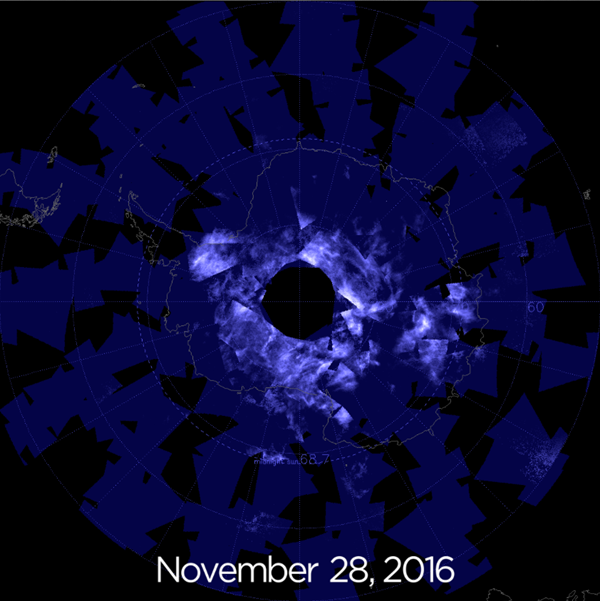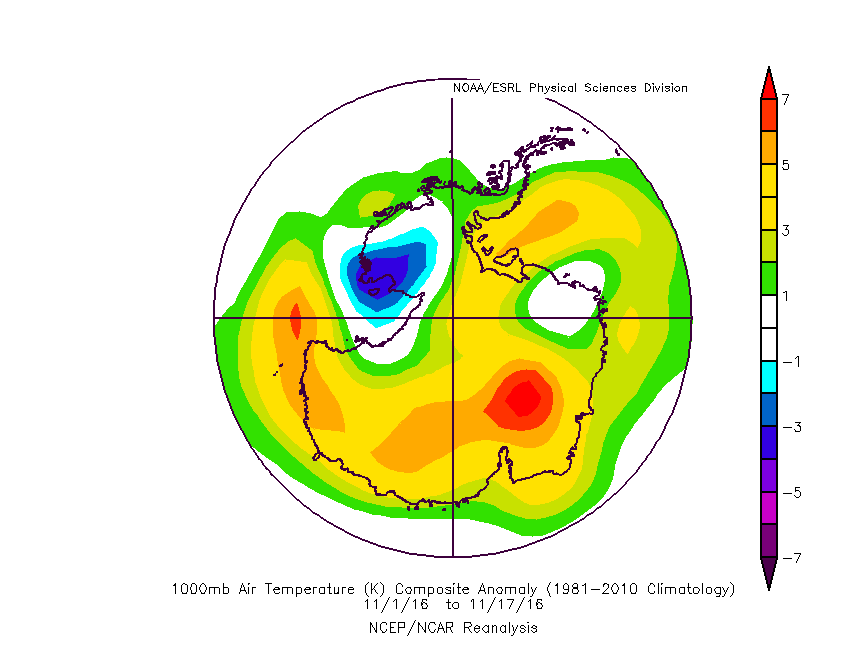As summer gets under way in the Southern Hemisphere, electric blue clouds seeded by meteor dust begin to glow high in the sky over Antarctica’s vast icy reaches.
This year, according to NASA, these night-shining, or “noctilucent,” clouds turned up much earlier than usual. This corresponds to an early seasonal shift into into the warmer season at lower altitudes over Antarctica.
Here’s how the space agency describes the spectacular phenomenon:
Noctilucent clouds are Earth’s highest clouds, sandwiched between Earth and space 50 miles above the ground in a layer of the atmosphere called the mesosphere. Seeded by fine debris from disintegrating meteors, these clouds of ice crystals glow a bright, shocking blue when they reflect sunlight.
If you’re wondering how sunlight can illuminate clouds at night, consider that the midnight sun has been present over most of Antarctica during much of November. In the animation above of AIM spacecraft data gathered over Antarctica — which shows noctilucent clouds evolving in the second half of the month — watch for the expanding dotted circle. This marks the edge of the region experiencing the midnight sun.
The onset of night-shining clouds over Antarctica was witnessed by NASA’s Aeronomy of Ice in the Mesosphere spacecraft starting on November 17th. That puts this year in a tie for the earliest start yet in the AIM record of the Southern Hemisphere. In the Southern Hemisphere, AIM has observed seasons beginning anywhere from Nov. 17 to Dec. 16.
According to NASA, noctilucent clouds are observed:
. . . seasonally, during summer in both the Northern and Southern hemispheres. This is when the mesosphere is most humid, with water vapor wafting up from lower altitudes. Additionally, this is also when the mesosphere is the coldest place on Earth – dropping as low as minus 210 degrees Fahrenheit – due to seasonal air flow patterns.
The warming of the relatively moist lower atmosphere that occurs during summer causes upwelling winds. These carry water vapor high into the mesosphere. This is why the clouds appear during summer, not winter.
But that by itself would not cause ice crystals to grow and collect into noctilucent clouds. The water molecules need something to stick to in order to form crystals.
In ordinary clouds lower in the atmosphere, dust whipped up by winds often serve the purpose. But the mesosphere is so high that another source of dust is needed.
That’s where meteor dust comes in. Many tons of tiny flecks of smashed up comets and asteroids enter the mesosphere every day. And as it turns out, much of this stuff is just the right size to seed the formation of the ice crystals that comprise noctilucent clouds.
Global warming may be helping the clouds spread by making the already frigid mesosphere even colder. That may sound like a contradiction, since greenhouse gases cause warming. But this is so in the lower reaches of Earth’s atmosphere. In the mesosphere, greenhouse gases actually serve to lower temperatures.
Did an earlier-than-normal shift to summer conditions in the lower atmosphere over Antarctica contribute to the early start of noctilucent cloud season there?
The lower atmosphere over Antarctica was, in fact, warmer than normal in the weeks leading up to the onset of the noctilucent clouds, as the graphic above shows. It’s possible that this enhanced the transport of water vapor up into the mesosphere, thus providing the raw materials needed for forming the clouds.
That’s an intriguing hypothesis. But it’s also important to keep in mind that the AIM mission has only been underway since 2007. So scientists do not have a long satellite record showing the onset and evolution of the noctilucent cloud season over Antarctica.
This article originally appeared on Discover.











